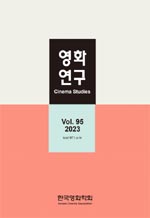이장호 감독의 네트워크를 통해 살펴본 1980년대 한국영화의 잔여문화와 부상문화의 혼종 풍경
Residual Culture and Emerging Culture Hybrid Landscape of Korean Cinema in the 1980s, Examined through Director Lee Jang-ho's Network: Focusing on youth culture and folk culture reproduced in Lee Jang-ho's <A Windy Day>
- 0

1980년대는 한국영화의 변곡점이다. 그 중심에 이장호의 <바람불어 좋은 날>이 자리한다. 한국영화사에서 1970년대는 충무로 시스템에 균열을 내며 예술영화를 지향하는 영상시대가 부상하며 1980년대에는 부상문화로 민중문화가 등장한다. 레이몬드 윌리암스는 지배문화와 잔여문화 그리고 부상문화가 서로 혼재하면서 문화를 형성하는 것에 주목하였다. 한국영화사에서도 대항문화로서 민중문화와 부상문화에서 잔여문화로 침윤한 청년문화가 혼종되면서 1980년대 한국영화의 변화를 촉발되었다. 충무로 영화관습은 신필름의 제작관행이 지배문화로 기저에 자리하였으며 부상문화는 1970년대 청년 문화 1980년대 민중문화가 서로 융합하였다. 이 과정에서 청년문화는 잔여문화로 자리를 바꾸면서 부상하는 민중문화와 융합하고 경합하면서 1980년대 한국영화의 새 지평을 열어갔다. 부상문화로서 청년문화가 충무로 지배문화와 충돌하면서 한국영화 변화를 주도한 <별들의 고향>, <바보들의 행진>, <겨울 여자>를 견인했다. 부상 문화에서 잔여문화로 자리 바꾼 청년문화와 부상하는 민중문화가 혼종된 작품인 <바람불어 좋은 날>이 1980년에 등장했다. 부상문화로 떠오르는 민중문화와 리얼리즘이 결합하면서 격동의 1980년대가 펼쳐졌다. 1980년대는 정치적으로 좌절된 민주화 시기였으며 문화적으로 민중문화를 통한 저항의식이 분출하여 민중적 리얼리즘 시대가 열렸다. 민중문화와 민중적 리얼리즘은 <바람불어 좋은 날>에 수혈되어 잔존한 청년문화와 결합하여 전통적인 충무로 방식에 균열을 내고 새로운 형식과 정신의 재무장에 일조하였다. 브루노 라투르의 네트워크 개념과 레이몬드 윌리암스의 잔여문화와 부상문화 시각에서 <바람불어 좋은 날>은 감독 이장호와 민중적 리얼리즘이라는 비인간적 사조와 마당영화의 네트워크의 산물이다. 이와 같은 시각에서 <바람 불어 좋은 날>은 한국영화사의 리얼리즘의 계보와 연결된다는 점과 영상시대의 새로운 언어에 대한 자각의 성과라는 점에서 지배문화와 부상문화의 혼종산물이다. <바람불어 좋은 날>은 신필름의 충무로 제작 관행과 한국적 리얼리즘이라는 지배문화와 청년문화, 민중적 리얼리즘이라는 부상문화와 잔여문화의 합작품이다.
Korean films in the 1980s are at an inflection point. Director Lee Jang-ho and <Good Windy Day>are at the center of it. In the history of Korean film, the Chungmuro system and the age of art films emerged in the 1970s, and popular culture emerged as a rising culture in the 1980s. Raymond Williams paid attention to the fact that dominant culture, residual culture, and emergent culture form cultures by coexisting with each other. In the history of Korean film, the popular culture as a counterculture and the youth culture that infiltrated into the residual culture from the emerging culture were hybridized, driving changes in Korean films in the 1980s. The film customs of Chungmuro were based on the production practices of Shin Film as a dominant culture, and the emerging culture was a fusion of youth culture in the 1970s and popular culture in the 1980s. In this process, youth culture changed its place to residual culture, fused and competed with the rising popular culture, opening a new horizon for Korean films in the 1980s. <Hometown of the Stars> and <Winter Woman>, which led the change in Korean cinema as the youth culture collided with the dominant culture of Chungmuro as emerging culture, were the products of young directors in the Youngsang era, and young people who changed their place from emerging culture to residual culture. The 1980's <Good Windy Day> is a work in which culture and emerging popular culture are mixed. Popular culture and realism remained transfused in <Good Windy Day> and combined with the reinterpreted youth culture, cracked the traditional Chungmuro method and contributed to the rearmament of a new form and spirit. With Bruno Latour's concept of network and Raymond Williams' concept of residual culture and rising culture, <Good Windy Day> can identify director Lee Jang-ho and the dehumanizing trend of popular realism and the network problem of madang cinema. From this point of view, <Good Windy Day> is a product of both the dominant culture and the emerging culture in that it is connected to the genealogy of realism in Korean film history and is a product of awareness of a new language in the age of video. It is also a networked combination of the Korean film tradition of realism, the shift from the emerging culture of the video era that represents youth culture to a residual culture, and the emerging popular realism.
1. 들어가는 말
2. 신필름의 입사 그리고 영상시대와 청년문화의 부상
3. 잔여문화로 자리 바꾼 청년문화와 부상하는 민중문화가 혼종된 <바람 불어 좋은 날>
4. 도시노동자의 삶을 반영하는 민중적 리얼리즘과 새로운 영화 언어로서 마당 영화의 실천
5. 결론
(0)
(0)